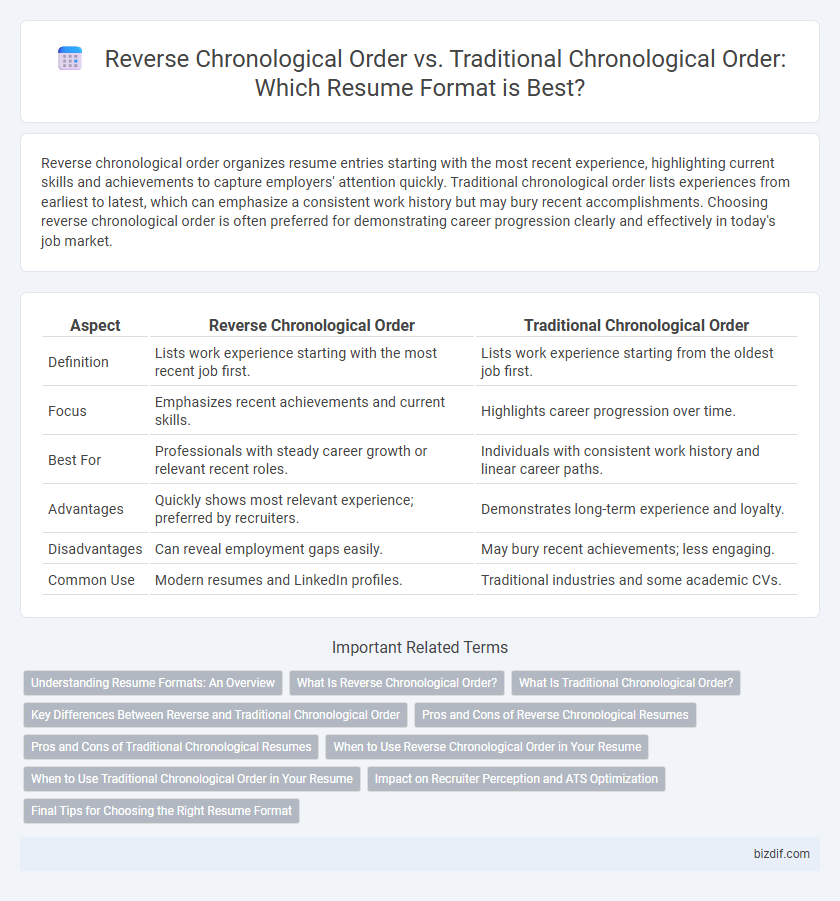Reverse chronological order organizes resume entries starting with the most recent experience, highlighting current skills and achievements to capture employers' attention quickly. Traditional chronological order lists experiences from earliest to latest, which can emphasize a consistent work history but may bury recent accomplishments. Choosing reverse chronological order is often preferred for demonstrating career progression clearly and effectively in today's job market.
Table of Comparison
| Aspect | Reverse Chronological Order | Traditional Chronological Order |
|---|---|---|
| Definition | Lists work experience starting with the most recent job first. | Lists work experience starting from the oldest job first. |
| Focus | Emphasizes recent achievements and current skills. | Highlights career progression over time. |
| Best For | Professionals with steady career growth or relevant recent roles. | Individuals with consistent work history and linear career paths. |
| Advantages | Quickly shows most relevant experience; preferred by recruiters. | Demonstrates long-term experience and loyalty. |
| Disadvantages | Can reveal employment gaps easily. | May bury recent achievements; less engaging. |
| Common Use | Modern resumes and LinkedIn profiles. | Traditional industries and some academic CVs. |
Understanding Resume Formats: An Overview
Reverse chronological order organizes work experience starting with the most recent position, highlighting current skills and career progression, making it ideal for professionals with a solid work history. Traditional chronological order lists jobs from the earliest to the latest, providing a complete career timeline but potentially burying recent achievements. Understanding these formats helps tailor resumes to industry expectations and applicant strengths, enhancing visibility to recruiters.
What Is Reverse Chronological Order?
Reverse chronological order in resume writing presents work experience by listing the most recent job first, followed by previous positions in descending date order. This format highlights recent achievements and career progression, making it easier for employers to assess current skills and qualifications quickly. It contrasts with traditional chronological order, which starts with the earliest experiences and moves forward, often used less frequently in modern resume practices.
What Is Traditional Chronological Order?
Traditional chronological order in resume writing presents work experience starting with the earliest position and progresses sequentially to the most recent. This format emphasizes continuous employment history and career development over time. Employers can easily trace job progression and assess long-term experience through this straightforward timeline approach.
Key Differences Between Reverse and Traditional Chronological Order
Reverse chronological order lists work experience starting with the most recent position, highlighting current skills and achievements, while traditional chronological order begins with the earliest job, showing a linear career progression. Reverse chronological resumes emphasize recent accomplishments and relevance to the job applied for, whereas traditional resumes provide a comprehensive career timeline. Choosing between these formats depends on the candidate's career history and the importance of showcasing recent roles over a sequential work record.
Pros and Cons of Reverse Chronological Resumes
Reverse chronological order resumes highlight the most recent job experience first, making it easier for recruiters to assess current skills and career progression. This format benefits candidates with a consistent work history but may expose employment gaps or frequent job changes. While it emphasizes relevant expertise, it can disadvantage those with less traditional career paths or significant early accomplishments.
Pros and Cons of Traditional Chronological Resumes
Traditional chronological resumes present work experience starting from the earliest position to the most recent, which clearly highlights career progression over time. This format is ideal for candidates with a steady work history but may disadvantage those with employment gaps or frequent job changes. Emphasizing long-term growth and loyalty, traditional chronological resumes can sometimes obscure recent achievements and skills relevant to the targeted job.
When to Use Reverse Chronological Order in Your Resume
Use reverse chronological order in your resume when highlighting recent job experience and career progression is essential, as this format showcases your most current roles first. This approach benefits professionals with a steady work history, emphasizing relevant achievements and skills gained in recent positions. Employers prefer this structure for its clarity in tracking job timelines and assessing recent qualifications.
When to Use Traditional Chronological Order in Your Resume
Traditional chronological order resumes suit candidates with consistent work histories and upward career trajectories, emphasizing stable employment and progression. This format highlights long-term roles and relevant experiences, making it ideal for professionals staying within the same industry or seeking roles aligned with their past positions. Employers favor this structure for its clear timeline, facilitating the evaluation of job stability and growth over time.
Impact on Recruiter Perception and ATS Optimization
Reverse chronological order enhances recruiter perception by showcasing the most recent and relevant experiences first, aligning with current industry trends and role requirements. This format optimizes ATS performance by prioritizing keywords in recent job descriptions, increasing the likelihood of higher ranking in algorithm-driven screenings. Traditional chronological order, while straightforward, may bury recent achievements deeper in the resume, potentially reducing immediate recruiter engagement and keyword effectiveness in ATS systems.
Final Tips for Choosing the Right Resume Format
Selecting the appropriate resume format hinges on your career history, with reverse chronological order best for showcasing recent achievements and traditional chronological order suitable for a consistent work timeline. Prioritize formats that highlight your most relevant skills and experiences aligned with the job description to capture the employer's attention quickly. Ensure clarity and ease of reading by maintaining consistent dates and a clean, professional layout to maximize the impact of your resume.
Reverse Chronological Order vs Traditional Chronological Order Infographic

 bizdif.com
bizdif.com